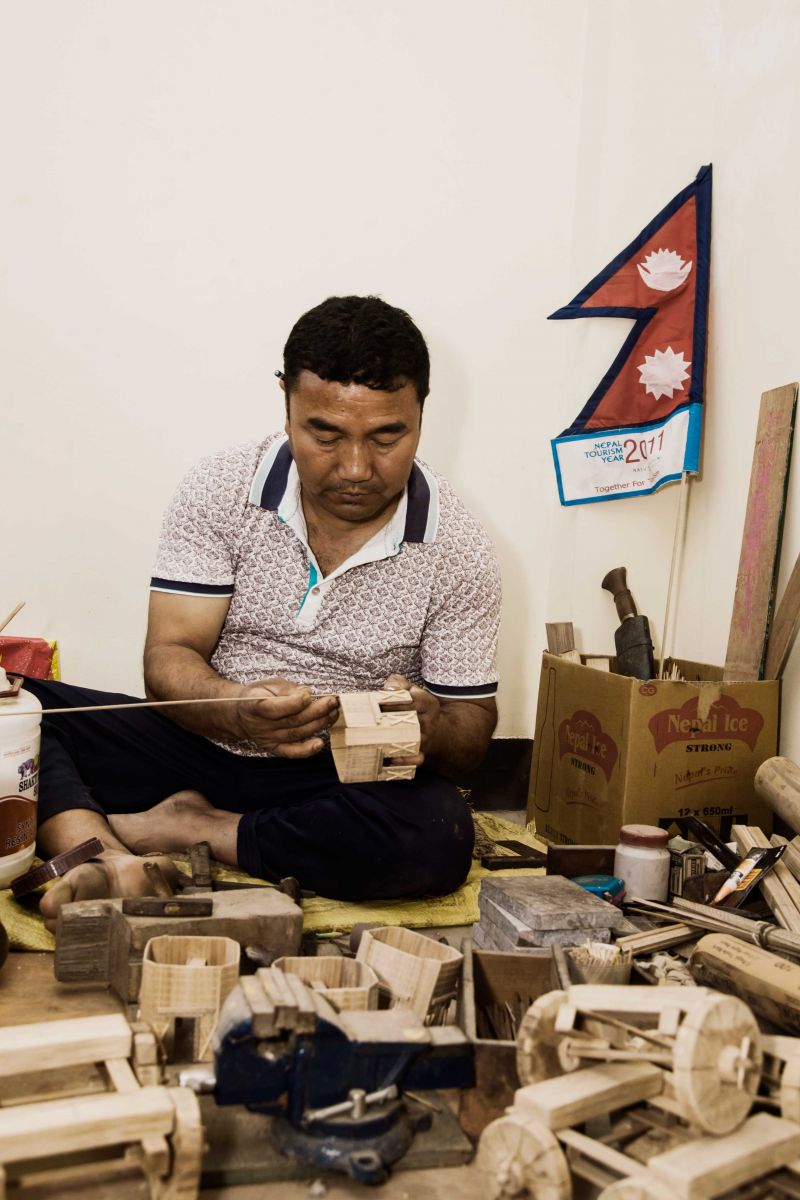
Most artists and craftsmen can make a living out of their respective works. Be it painters, sketchers, sculptors, potters, carvers, they are all respected for their work, and despite challenges, most are able make a living out of their beautiful creations. However, there are a few sidelined and lesser known crafts that aren't always put on a pedestal and celebrated.
Like other craftsmen, Mukti Nath Maharjan also wanted to turn his unique bamboo craft into a decent income generating profession. Born and brought up in Tanani, Kirtipur, he is a carpenter by profession, who makes beautiful miniature bamboo replicas of famous temples and idols of Nepal in his free time. Despite getting a lot of appreciation from his friends, not being able to commercially sell his craft became a major demotivating factor and road block.
He had learnt the craft around 20 years ago from a friend named Kesh Man. They used to go to their Aakha chhen to play musical instruments in their free time at night. Kesh Man used to return home before the others, and even when Mukti called him, he didn't come out. One day, a curious Mukti peeked into Kesh Man's room to see that he was making miniature idols out of bamboo. The astonishing fact was that he was using only a knife and a blade to make the miniatures. After seeing this, Mukti felt that he would also be able to do it, and started trying it himself. His carpentry knowledge served as an advantage while working on the bamboo craft. Initially, the difficult part of making the models was aligning all the tuna: shi (the supporting wood) used in Nepali style buildings. After mastering the alignments, his miniatures looked tidy, with a professional finishing touch. This gave him the motivation to make more of such models.
When his sister was getting married, she told him that she didn’t want any other gifts, but would love to have a miniature model of a temple made by him, as it would mean a lot to her. He made her a miniature Pashupati Temple model. That was the first bamboo model he ever made. As he continued to work and improve his craft, he realized that the first one that he had made didn't at all look nice in comparison to his later works. So, he offered to give her a new model with better finishing and take back the old one he had given earlier. But she refused to give it back, saying it didn’t matter whether it was good or bad, it was special, because it was the first one he made.
At first, he painted parts of the models with a golden color, but others advised him not to paint on them, as they don’t look as genuine, and also, people would not know what they were made of. Thus, his models now come without a single trace of paint. They are made solely of bamboo parts, using basic carpentry tools and glued together with Fevicol. He says the thinner that they can cut the bamboo, the better it is. It takes one to two weeks for him to make one model all on his own. He remembers that, when there used to be load-shedding, he would work in the light of a tuki mata (oil lamp).
When his sons grew up, they and their friends encouraged him to continue this craft again. They also created a Facebook page called Mukticrafts with their unique logo, featuring six of his miniature models. After this, the demand for his craft has increased. Art collectors have approached him and bought his creations. His son is actively working towards promoting the craft; he would like to place his father's creations as decorations in Nepal’s leading hotels.
 But, Mukti says he doesn't feel the same level of motivation today that he did when he started out. There is a sad story to it, which he shared with us. Two to three years ago, a young man studying in the U.S. had approached him during his short time in Nepal, with a proposal to sell his miniature models abroad. He had a special request, which was to make the miniature model of the Bunga Dyo, or Red Machhindranath, chariot of Patan. Mukti fulfilled the special request in twelve days. The young man was impressed by the model and confirmed the deal, which was to not assign a price on the models beforehand, but to display them in an exhibition and determine the price after seeing how much people were willing to pay for them abroad. Mukti had liked the idea. The young man had gone on a Langtang trek just before flying back to the U.S., but he went missing. His phone was unreachable. Mukti had pinned a lot of hopes on him. He had even gone to light butter lamps at Bagh Bhairab to pray for his recovery. Later, they came to know that he had lost his life by being buried in the snow at Langtang. This shook and depressed Mukti a lot and discouraged him from continuing his craft.
But, Mukti says he doesn't feel the same level of motivation today that he did when he started out. There is a sad story to it, which he shared with us. Two to three years ago, a young man studying in the U.S. had approached him during his short time in Nepal, with a proposal to sell his miniature models abroad. He had a special request, which was to make the miniature model of the Bunga Dyo, or Red Machhindranath, chariot of Patan. Mukti fulfilled the special request in twelve days. The young man was impressed by the model and confirmed the deal, which was to not assign a price on the models beforehand, but to display them in an exhibition and determine the price after seeing how much people were willing to pay for them abroad. Mukti had liked the idea. The young man had gone on a Langtang trek just before flying back to the U.S., but he went missing. His phone was unreachable. Mukti had pinned a lot of hopes on him. He had even gone to light butter lamps at Bagh Bhairab to pray for his recovery. Later, they came to know that he had lost his life by being buried in the snow at Langtang. This shook and depressed Mukti a lot and discouraged him from continuing his craft.
On the day we visited his workplace in his home, he was working on one of the Bunga Dyo chariots. So far, he hasn't taught the craft to anyone, as nobody has shown an interest in learning it. He also went to handicraft fairs to show photos of his work and find out their value. He didn't find the same craft anywhere. He doesn't prefer showcasing his work in the fairs, because he doesn't want to disappoint people, in case the demand exceeds what he can supply alone. Currently, he is busy fulfilling orders generated by his Facebook page alone.
Bagh Bhairab is a famous temple revered by the people of Kirtipur. Hence, the Bagh Bhairab Temple's model is in huge demand amongst the people of Kirtipur. The people of Lalitpur prefer buying the Bunga Dyo replica, as the Bunga Dyo Jatra is the biggest festival in Lalitpur. Falchha is also another in-demand product. Falchha is an outdoor resting place, like a patio. His other available models are Uma Maheshwor Temple, Pashupati Temple, and Nyatapola Temple of Bhaktapur. He is planning on making a replica of Kumari's chariot, as well. He also plans to make a Newa chhen (traditional Newar house) model in the future, because his clients are mostly Newars.
His unique and rare craft deserves attention, respect, and a stable income. If people could learn the craft from him and further explore it, the beautiful craft could achieve greater heights and recognition in the future.










